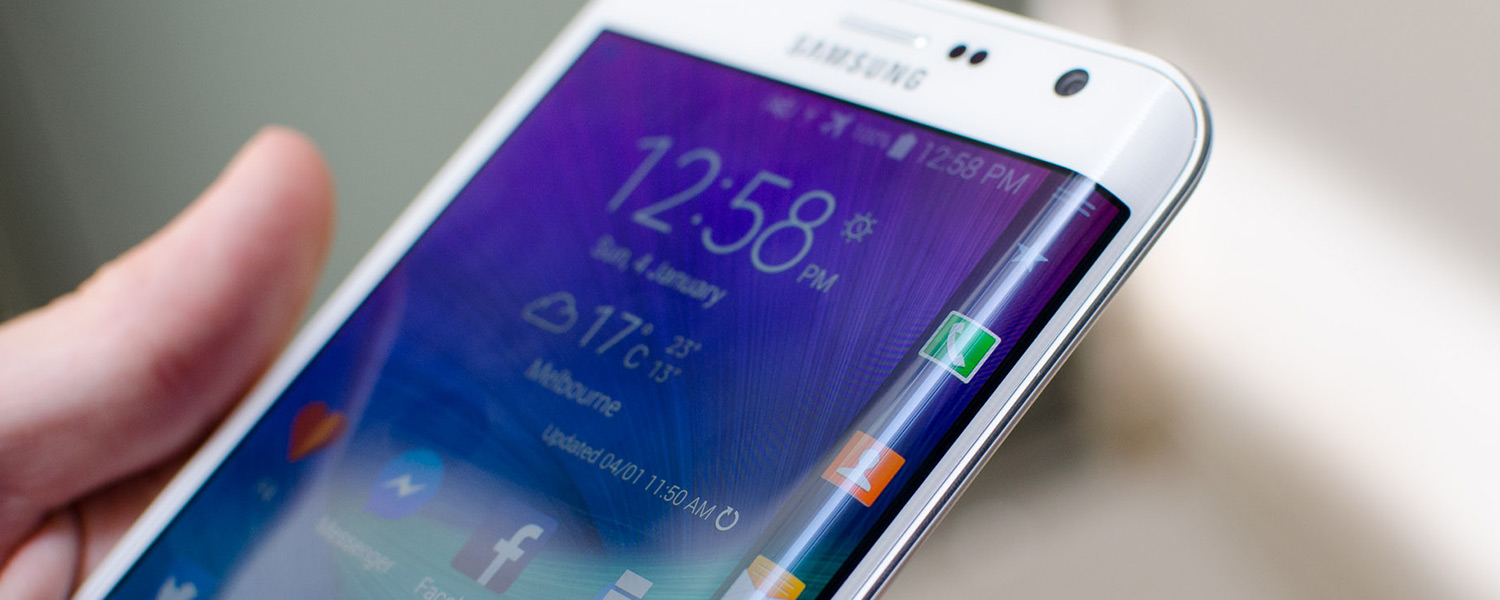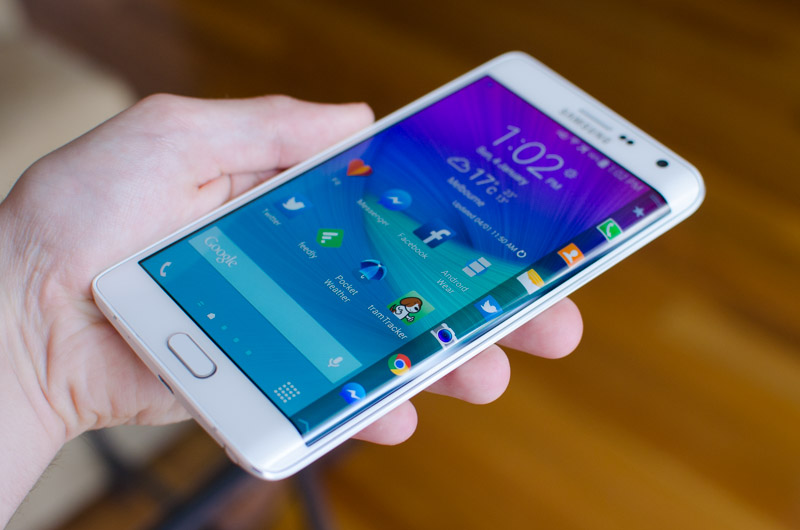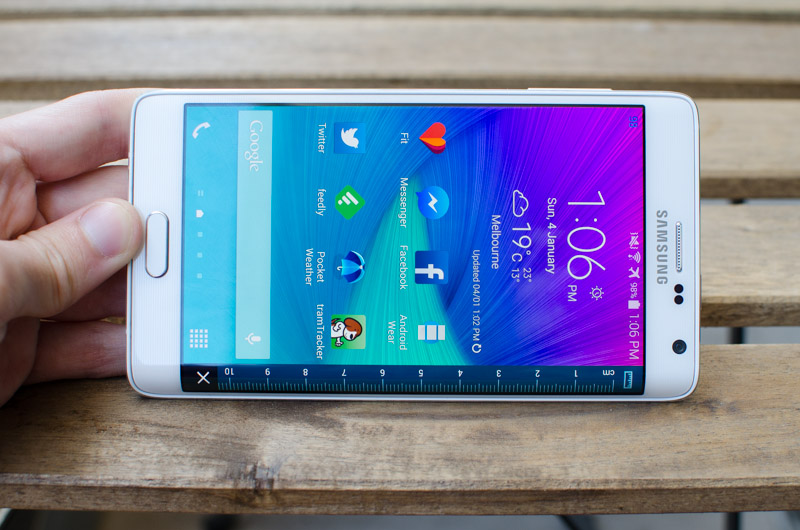The Edge
The main reason to purchase the Galaxy Note Edge is to get the Edge screen, a curved portion of AMOLED that acts as a conduit for several unique software features. It's an extra 160 x 2560 of resolution added to the main 2560 x 1440 display, increasing the panel's overall resolution to a familiar 2560 x 1600 with a 16:10 aspect ratio. The entire display is 5.6-inches in size for a pixel density of 539 PPI: slightly smaller and denser than the regular Note 4.
The quality of the AMOLED used in the Note Edge is pretty much the same as the Note 4, meaning you're getting generally fantastic color reproduction on a sharp, high resolution display. The curve can introduce some distortion when content approaches it, but that shouldn't be a huge issue.
It's interesting to note how the Note Edge handles regular apps and 16:9 content on the curved display. Most applications and games will fill the maximum area allocated to it - 2560 x 1532 - which extends from the left edge to the start of the curve. This is slightly larger than 16:9, though most applications these days can scale somewhat correctly to the odd resolution. Native 16:9 content like photos captured by the camera or 1080p videos will sit in the center of this allocated screen space, which overall is off-center by a few pixels from the center of the device.
In any application that hasn't been coded to specifically use the Edge screen, a strip of text will be displayed on the curved portion of the display that's not used for app content. You can customize this text, and that's about it. How useful.
The main feature that harness the power of the Edge are Edge screen panels. These panels are 160 pixels wide, sit directly on the curve, and show various things. One panel gives you shortcuts to your favorite apps, another shows notifications, and another shows the latest news headlines. By flicking across the curve, you can access the other panels in a simple fashion. Pulling down from the top of any panel reveals a selection of tools, such as a ruler, stopwatch, voice recorder and flashlight switch, all of which utilize only the space on the Edge screen.
I'll admit that the Edge screen and its panels have some very useful features. The panels are always displayed on the homescreen or can be accessed by flicking right in any application, so I find myself mostly launching applications or switching between them by using the favorite apps panel. You can have as many applications as you like in here, so I loaded it up with basically everything I use and it becomes a very handy launcher and multi-tasker.
To a lesser extent, tools like the stopwatch and ruler are handy to have in such an accessible way. Some other panels I found myself glancing at from time to time, such as one that shows data usage, and another that allows me to control music playback. The notification panel was also useful, especially as any incoming notifications will automatically reveal the panel (regardless of what app you're in) and show you a ticker-style readout of what the notification contains.
Other panels I found largely useless. News tickers aren't a great way of getting the latest headlines, as it's easier and quicker to hop into an app or head to your favorite website to read the news. This is mostly because the Edge screen has limited space to display information, and showing just one or two headlines is hardly useful for at-a-glance info.
You can also play games on the Edge screen. They suck. End of story.
But the main issue I have with the Edge screen, and why I think it's a massive gimmick, is that none of these features actually require the curved display at all. There is absolutely no reason whatsoever why the Edge panels couldn't be implemented into the software without having a curved display. Heck, Samsung could very easily implement the Edge on the Galaxy Note 4 with few issues.
The reason for this is that you already have to swipe from the right edge of the handset to reveal the Edge screen features in most apps. The Edge screen also already covers a small portion of an app's content, and takes away your focus from the app itself; it's not designed for side-by-side multitasking. Therefore there's no reason why the Edge screen couldn't be activated from a standard display like the Note 4's. Instead of the Edge screen panels sliding over a blank section of curved display, they could side over a small portion of an app's content on a regular, flat display.
This implementation would keep all the useful aspects of the Edge screen - like the handy favorite apps panel, the easy-access ruler, and notification panels - and remove all the design awkwardness of actually having a curved display. As part of the display would no longer be blank most of the time (nor displaying a pointless line of text), the phone would look slicker during operation. Admittedly it wouldn't be as 'cool', but it would still be a handy software inclusion that extends on the standard Android experience if done correctly.
That said there are some aspects of the Edge screen that can't be replicated on a standard non-curved display. In some apps (literally one or two), buttons and controls are placed into the curved section of the display. The app that most notably does this is the camera app, which keeps the camera preview completely free of icons and places the shutter controls and other settings into the Edge.
It's a novel idea, and I like how the camera preview is uncluttered. However the position of the camera shutter in this curved section is actually harder to hit while holding the device in a comfortable position, at least compared to the location used on most other smartphones.
The final Edge screen feature, and one of the more useful ones, is the night clock. When the night clock is enabled, the curved portion of the display will show the time, today's weather, and the date when the display is 'off' and it's between the times you set. You could have the Note Edge charging on your bedside table, for example, and by having it display the time it becomes a perfect clock. The angle of the curve is also great for viewing the clock in this situation.






